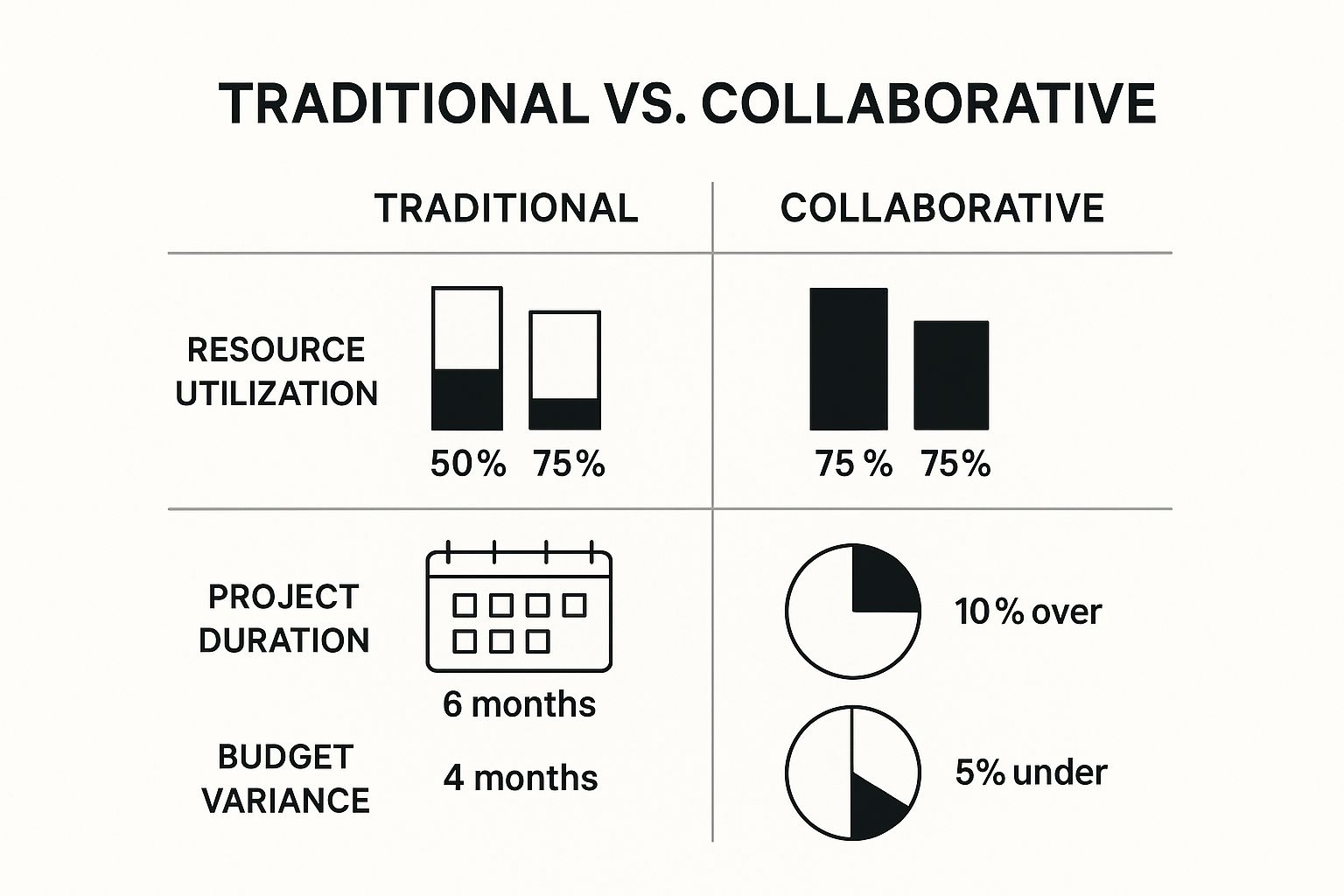
Unlock Success with Collaborative Resource Management
Share
The Modern Evolution of Collaborative Resource Management

Traditional resource management often involved separate teams, closely guarded information, and inefficient resource allocation. Today's fast-paced business world requires a more effective approach. Collaborative resource management emphasizes shared resources, open communication, and flexible strategies. This represents a major shift in how successful organizations operate.
Breaking Down Silos: The Core of Collaboration
Imagine a marketing team keeping valuable data from the sales team. This outdated, siloed approach limits the entire organization's potential. Collaborative resource management works to eliminate these barriers. Resources—data, personnel, or technology—become shared assets, available to whoever needs them, whenever they need them.
This change is driven by the understanding that collaboration is essential for agility and innovation. The increase in remote and hybrid work further emphasizes the need for tools and strategies that facilitate seamless teamwork. This requires a move away from rigid departmental structures and toward more flexible models.
The market for collaborative resource management tools reflects this growing demand. In 2023, the global market for these tools was valued at approximately $39,407.4 million. It's projected to reach $116,338.4 million by 2033, with a compound annual growth rate (CAGR) of 11.4%. This impressive growth highlights the increasing demand for tools that support remote teams, improve workflows, and boost productivity. For more in-depth statistics, check out this resource: Learn more about workplace collaboration statistics
The Psychological Shift: Embracing Shared Success
Collaborative resource management isn't just about new software; it's about a fundamental change in how we think about teamwork. It involves building a culture of trust, transparency, and shared responsibility. Teams must move away from a competitive mindset and embrace shared success.
Organizational Structures: Supporting Collaboration
This shift also requires updated organizational structures. Traditional hierarchical models can often hinder collaboration, while more agile, network-based structures encourage it. These newer structures empower individuals and teams to make decisions quickly and adapt to change, fostering better collaborative resource management. This offers organizations a chance to become more responsive, innovative, and ultimately, more competitive. The future of successful businesses hinges on their ability to adopt this collaborative approach to resource management.
Business-Transforming Benefits You Can't Ignore
Collaborative resource management is more than just a popular concept. It's a powerful approach offering tangible, business-transforming benefits. When organizations embrace collaborative resource management, they unlock a cascade of positive impacts across their entire operation. These improvements aren't small; they represent substantial shifts in operational efficiency, cost savings, and project delivery timelines.
Efficiency Gains and Cost Reduction
One of the most immediate benefits of collaborative resource management is a significant increase in efficiency. By breaking down information silos and making resources easily accessible across teams, organizations eliminate redundancies and optimize resource use. This creates a ripple effect of cost savings.
Projects are completed faster, resources are used more effectively, and operational costs are reduced. This translates into increased profitability and a stronger bottom line for the company.
To illustrate these advantages, let's look at a comparison of traditional and collaborative resource management. The following table highlights the key differences between the two approaches.
Comparing Traditional vs. Collaborative Resource Management
| Aspect | Traditional Resource Management | Collaborative Resource Management |
|---|---|---|
| Resource Utilization | 50% | 75% |
| Project Duration | 6 months | 4 months |
| Budget Variance | +10% (Overrun) | -5% (Savings) |
As the table shows, collaborative resource management leads to a substantial improvement across these crucial metrics. This model fosters a more streamlined and efficient use of resources, ultimately benefiting the organization's bottom line.
The infographic below further visualizes these key differences:

These improvements—a jump in resource utilization from 50% to 75%, reduced project durations from 6 months to 4 months, and budget shifts from 10% overruns to 5% savings—showcase the real-world impact of this approach.
Accelerated Project Delivery and Innovation
This boost in efficiency directly translates into faster project delivery. With readily available resources and synchronized teams, projects progress at a quicker pace. This means faster time-to-market for new products and services, providing a significant competitive advantage.
This accelerated pace also creates opportunities for innovation. When teams have the resources they need and can collaborate effectively, they can experiment, iterate, and develop groundbreaking solutions. This strengthens the innovation pipeline and cultivates a culture of creativity within the organization.
Improved Employee Satisfaction and Talent Retention
The benefits of collaborative resource management extend beyond operational improvements. By fostering transparency, trust, and shared responsibility, it significantly improves employee satisfaction. When employees feel valued, empowered, and connected, they are more engaged and productive.
This positive work environment also plays a crucial role in talent retention. In a competitive job market, companies that prioritize collaboration and employee well-being attract and retain top talent. Organizations become more efficient and build stronger, more resilient teams.
For example, the global team collaboration software market is valued at $36,114.2 million. It's projected to grow at a CAGR of 7.4% from 2025 to 2030, driven by the increasing need for tools that support distributed teams. You can learn more about this growing market here.
Ultimately, collaborative resource management transforms businesses. It cultivates collaboration, innovation, and shared success, driving sustainable growth and long-term competitive advantage. These combined benefits make a compelling case for organizations to adopt collaborative resource management as a core business strategy.
Essential Tools That Actually Drive Collaboration

Effective collaborative resource management hinges on selecting the right tools. This means looking past marketing hype and focusing on platforms that truly support collaborative workflows. This involves assessing a variety of platforms, from complete project management suites to specialized resource visualization tools. The key isn't chasing the latest features, but finding what truly improves resource optimization and encourages team adoption.
Evaluating Tools for Genuine Impact
There's a significant difference between impressive product demos and actual workplace usefulness. To choose effective tools, concentrate on features that truly impact daily operations. For example, real-time resource tracking and automated reporting are much more valuable than flashy visuals that lack actionable insights.
User-friendly interfaces and seamless integrations are also essential for encouraging team adoption. No one wants to struggle with complicated software. Prioritizing ease of use is critical for long-term success.
You might be interested in: Team Collaboration Tools Comparison
Integrating Tools Without Creating Silos
Implementing new tools can unintentionally create new silos if not integrated correctly. A core principle of collaborative resource management is open access and shared information. This means chosen tools must integrate smoothly with existing systems to prevent data fragmentation.
For example, a project management platform should connect with communication tools like Slack and resource databases. This creates a unified view of project status and resource allocation. This unified approach ensures everyone accesses the same information, leading to improved communication and decision-making.
Categories of Collaborative Resource Management Tools
Effective collaborative resource management often involves using different tools for specific purposes. Several categories stand out for streamlining resource allocation and improving team collaboration:
- Project Management Suites: These platforms provide comprehensive features for managing tasks, timelines, and resources, acting as a central hub for project information and facilitating team communication.
- Resource Visualization Tools: These tools offer a visual overview of resource allocation, simplifying the process of identifying potential bottlenecks and optimizing resource use. Gantt charts and resource histograms are common examples.
- Communication Platforms: Tools like Slack or Microsoft Teams facilitate real-time communication and information sharing, essential for keeping distributed teams aligned.
- File Sharing and Collaboration Tools: Platforms like Google Workspace or Dropbox enable seamless file sharing and co-editing, promoting efficient collaboration on documents and other resources.
When integrated effectively, these tools create a robust ecosystem for collaborative resource management, supporting efficient workflows and informed decisions.
Building a Tech Stack That Grows With Your Team
Successful organizations build technology stacks that can adapt as their collaborative maturity progresses. They start with core tools for immediate needs and incorporate more specialized platforms as they gain experience. This measured approach prevents overwhelming teams with too many tools at once.
This also allows organizations to customize their tech stack to their specific needs, ensuring the technology supports collaborative efforts as organizational needs evolve. Choosing adaptable tools and integration strategies is essential to preventing future silos.
Building Your Collaborative Resource Management Roadmap
Transitioning to collaborative resource management isn't a quick fix. It's a strategic journey. This section offers a practical roadmap for organizations at any stage of collaborative maturity. By learning from the experiences of leaders who have successfully implemented these changes, you can effectively assess your current state, pinpoint high-impact starting points, and sequence initiatives for maximum effect.
Assessing Your Current Collaborative State
Before beginning a collaborative resource management journey, it’s crucial to understand where your organization currently stands. This involves honestly evaluating existing workflows, communication patterns, and technology usage.
For example, consider how resources are currently allocated. Are they centralized or scattered across departments? How easily can teams access and share resources? Answers to these questions will reveal your baseline for improvement.
Identifying High-Impact Starting Points
Not all collaborative initiatives are created equal. Some will yield faster, more noticeable results than others. For example, implementing clear decision-making rules for resource allocation can be a quick win. This can quickly resolve bottlenecks and reduce conflicts.
When choosing tools for collaborative resource management, consider solutions focused on enhancing productivity and collaboration. Additionally, focusing on team structure planning can improve efficiency by clearly defining roles and responsibilities. These "quick wins" build momentum and demonstrate the value of collaboration.
Sequencing Initiatives for Maximum Momentum
Successfully implementing collaborative resource management requires a phased approach. Start with foundational elements like team structure and clear communication protocols.
Then, gradually introduce more complex initiatives like resource forecasting and results-based planning. This allows organizations to adapt to changes incrementally and avoid overwhelming teams.
Overcoming Barriers to Collaboration
Transitioning to collaborative resource management isn't always smooth. Expect resistance to change, especially in organizations with deeply ingrained siloed mentalities. Addressing these challenges head-on is critical.
-
Change Resistance: Acknowledge concerns and address them proactively. Highlight the benefits of collaboration for both individuals and the organization.
-
Cross-Departmental Resource Sharing: Implement clear governance models and resource tracking systems to ensure fair and transparent allocation. This helps mitigate political challenges and builds trust.
Balancing Quick Wins With Long-Term Change
It’s important to balance quick wins with long-term structural changes. Quick wins generate excitement and demonstrate the value of collaboration. However, sustainable success requires addressing deeper organizational structures.
This might involve rethinking traditional departmental boundaries or implementing new technology systems. Learn more in our article about proven strategies for collaborative resource management.
Building an Enabling Governance Model
Effective governance is essential for collaborative resource management. This doesn't mean creating restrictive rules. Instead, it involves establishing clear guidelines for resource allocation, decision-making, and performance measurement.
A well-designed governance model empowers teams to collaborate effectively while maintaining necessary controls. This ensures resources are used responsibly and aligned with organizational goals.
Human-Centered Practices That Supercharge Collaboration

Technology provides the tools, but the success of collaborative resource management depends on people. This section explores the vital human factors that influence whether these initiatives thrive. These often-overlooked elements form the bedrock of successful resource sharing.
Cultivating Psychological Safety
A team where everyone feels comfortable sharing ideas, even unconventional ones, is key. This environment of psychological safety is essential for collaborative resource management. It fosters open communication and risk-taking, which are vital for innovation and problem-solving. When team members feel safe to express themselves, they're more likely to contribute fully.
For example, someone might hesitate to suggest a new resource allocation strategy for fear of ridicule. But in a psychologically safe environment, this same suggestion could lead to significant improvements. This is because psychological safety builds trust, allowing teams to benefit from diverse perspectives.
Communication Protocols For Diverse Teams
Effective communication is the cornerstone of collaboration. Clear communication protocols are essential, especially for diverse teams. This involves establishing clear expectations for how information is shared, decisions are made, and feedback is given. This clarity minimizes misunderstandings.
Furthermore, these protocols should account for different communication styles. Some prefer concise communication, while others value detailed explanations. Accommodating these differences is crucial for building a cohesive and productive team.
Decision Frameworks: Balancing Autonomy And Alignment
Collaborative resource management requires a balance between team autonomy and organizational alignment. Decision frameworks provide structure for decision-making that respects both. They empower teams to make decisions within defined parameters, ensuring alignment with strategic objectives. This balance is vital for effective resource use.
To further illustrate the importance of establishing clear communication protocols and decision-making frameworks within an organization striving for effective resource management, the following table outlines a maturity model. This model provides a roadmap for organizations to assess their current capabilities and identify areas for improvement:
Collaborative Resource Management Maturity Model
This table presents a framework for assessing and developing an organization's collaborative resource management capabilities across different maturity levels.
| Maturity Level | Characteristics | Tools & Processes | Organizational Behavior | Next Steps |
|---|---|---|---|---|
| Initial | Ad-hoc collaboration, limited communication, inconsistent resource allocation | Basic email, spreadsheets | Siloed teams, limited trust | Establish basic communication channels, define roles and responsibilities |
| Defined | Formalized communication channels, documented processes, defined resource allocation criteria | Project management software (Asana), shared calendars | Increased cross-functional communication, growing trust | Implement collaborative resource management tools, develop training programs |
| Managed | Real-time resource visibility, automated workflows, performance tracking | Resource management software, reporting dashboards | Proactive collaboration, shared understanding of goals | Optimize resource utilization, foster a culture of continuous improvement |
| Optimized | Predictive resource allocation, data-driven decision making, continuous feedback loops | Advanced analytics platforms, AI-powered tools | High levels of trust and transparency, continuous learning | Integrate collaborative resource management into strategic planning |
Key insights from this model highlight the progression from ad-hoc collaboration to a data-driven approach. This journey emphasizes the importance of tools, processes, and behavioral shifts to optimize resource management.
Redefining Leadership For Collaboration
Leaders are crucial in fostering collaborative behaviors. This involves moving away from traditional top-down management and towards a more inclusive approach. Leaders should model collaborative behaviors, encourage open communication, actively seek input, and reward cross-functional cooperation. You might be interested in: Learn more about the collaborative consumption business model.
Recognition And Feedback Mechanisms
Recognizing collaborative efforts reinforces the value of teamwork. Recognition systems shouldn't just reward individual achievements but also celebrate successful collaborations. This reinforces the importance of shared success.
Likewise, feedback mechanisms enable continuous improvement. Regular feedback, both positive and constructive, helps teams identify areas for improvement and strengthen their collaborative skills. This fosters a culture of learning and growth. By prioritizing these human-centered practices, organizations create a fertile ground for collaborative resource management to flourish. This approach acknowledges that while technology provides the tools, people drive collaborative success.
Measuring What Matters in Collaborative Success
Collaborative resource management isn't simply about putting a system in place; it’s about constantly striving for better results. This means focusing on the right metrics to ensure your collaborative efforts are truly paying off. This section digs deeper than surface-level numbers to identify the indicators that genuinely reflect collaborative success.
Identifying Key Performance Indicators (KPIs)
Organizations that excel at collaboration understand the importance of choosing Key Performance Indicators (KPIs) that align with their collaborative objectives. These KPIs generally fall into three main categories:
-
Operational Metrics: These assess the efficiency of collaborative processes. Examples include resource utilization rates, project completion rates, and time-to-market for new products. Seeing significant improvement in these areas suggests enhanced efficiency through collaboration.
-
Financial Metrics: These demonstrate the real-world financial impact of collaborative efforts. Metrics like cost savings, revenue growth, and return on investment (ROI) reveal the bottom-line benefits of optimized resource allocation. For example, a decrease in operational costs directly linked to collaborative resource management showcases its financial value.
-
Cultural Metrics: These evaluate the less tangible, yet equally important, aspects of collaboration. Employee satisfaction scores, team cohesion ratings, and cross-functional communication frequency offer insights into the health of your collaborative culture. These metrics are vital for gauging the long-term sustainability of a collaborative environment.
Establishing Baselines and Setting Targets
After identifying your KPIs, the next crucial step is establishing meaningful baselines. This provides a point of comparison to track progress. For instance, if your current resource utilization rate is 60%, this becomes your baseline for improvement.
Next, set realistic yet ambitious targets. If your baseline resource utilization is 60%, aiming for 70-75% within a defined timeframe would be a reasonable goal. This targeted approach promotes continuous improvement without setting unattainable expectations. Effective, people-focused practices often incorporate collaborative decision making strategies.
Implementing Measurement Systems
Effective measurement shouldn’t create extra work. Integrate measurement seamlessly into existing workflows and utilize technology to automate data collection. This streamlined approach delivers valuable insights without increasing administrative burden.
Advanced Measurement and Visualization
Elevate your measurement efforts by exploring more advanced metrics:
- Collaboration Intensity: Monitor how often teams interact and share information to quantify collaboration levels.
- Resource Optimization Rates: Calculate how effectively resources are being utilized compared to their full potential.
- Cross-Functional Effectiveness: Analyze how well different departments work together to achieve common goals.
Visualizing these insights through dashboards and reports makes the information easily digestible for stakeholders. This transparency fosters a shared understanding and supports data-driven decision-making.
Iterative Improvement and Adaptation
Measurement isn’t a one-time activity; it's a continuous process. Regularly review your KPIs, targets, and measurement systems to ensure they remain relevant and effective. Adjust your approach as needed based on the insights you gather. This iterative process ensures your collaborative resource management strategies constantly evolve to meet changing business needs.
Ready to optimize your resource management and unlock the full potential of collaboration? AccountShare empowers teams to share resources efficiently and securely, maximizing their impact and driving meaningful results. Learn more about how AccountShare can transform your organization at https://accountshare.ai.
